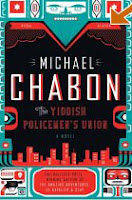
Chabon, Michael. The Yiddish Policemen's Union. I loved The Amazing Adventures of Kavalier & Clay, but this novel is so different. I mean really different. It is a conglomeration of a novel with elements of several genres all rolled into one. It is an alternate history, and it took me a while to realize that; I found myself asking why I'd never heard of... Well, let us just say that Chabon plants you right in the middle of an alternate history (liberally mixed with both actual and fictional facts) and never bothers to look back and see if you might need help interpreting his world or even realize what is going on. It is a mystery and a bit of hard-boiled detective fiction. It is full of references to Jewish culture which ( given the fictional historical facts that threw me off) could be accurate...or not. Lots of Yiddish terms that must be figured out by context. Or are they terms specific to Sitka, Alaska?
No concessions here, folks. You are along for the ride, or not, and Chabon is going his merry way regardless. I vacillated between pleasure and annoyance, fun and frustration, but I never put it down for long.
There is a murder. There is a divorced and frequently drunken policeman. An Indian Jew. a possible Tzaddik Ha-Dor. An ex-wife. A boundary maven. A sect of black hat ultra-religious gangsters. And more, much more.
I loved Landsman and Berko. What a team. In fact, Chabon's major cast of characters are dynamic - they almost come off the page (and in the case of Rebbe Shpilman, you really don't want that to happen); they are flawed, vulnerable, charming, chilling, and believable. At least, in the alternate history of Sitka, Alaska. One of my favorite characters doesn't come in until the last portion of the book, but he was definitely worth waiting for.
As a finished product - it is perhaps a bit too entangled and it sometimes drags. You want to say, "Enough with the similes, Chabon! Get on with the story!"
While not nearly as good as The Amazing Adventures of Kavalier & Clay, Michael Chabon makes you care, he makes you laugh, and if you can get past the confusion, he makes you realize what a feat this novel is. Then again, maybe one just can't compare apples and oranges.
Fiction. Mystery? Alternate history? 2007. 411 pages.

























